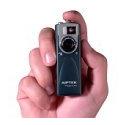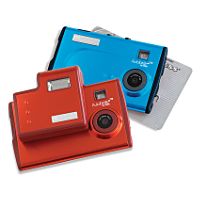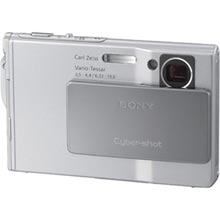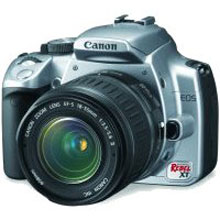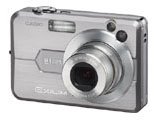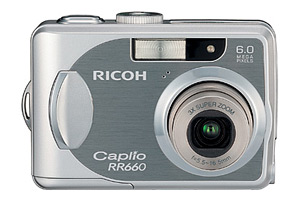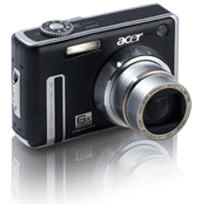On February 26th 2006, in a packed press conference on the first day of PMA 2006 Panasonic revealed their first digital SLR, the DMC-L1. The DMC-L1 represents another first, it's the first non-Olympus Four Thirds digital SLR which has to be good news for the system which has up until now been an Olympus only affair. When it was announced many noted the resembelence to the E-330, this is no coincidence as the DMC-L1 shares its optical subsystem (lens mount, mirror box, viewfinder, auto focus and exposure sensors) with the Olympus E-330.
The L1 features the same 7.5 megapixel 'LiveMOS' sensor used in the E-330 (which we now know is manufacturered by Panasonic), this provides the camera with TTL live view capability in a similar manner to the E-330. Unlike the E-330 however the DMC-L1 does not have a secondary Live View CCD and so provides only one Live View mode, this is known as 'B mode' on the E-330 and utilizes the main image sensor. The downside to this is that although the DMC-L1 provides auto focus in Live View it requires the mirror to be lowered and raised again during focusing.
Leica D Lens provides a superior optical performance and matches perfectly with the digital SLR camera body.
The DMC-L1 benefits from a new LEICA D VARIO-ELMARIT 14-50mm/F2.8-3.5 lens equipped with an aperture ring, focus ring and zoom ring, for easy, direct aperture setting. With a focal length range equivalent to 28mm (wide) to 100mm (medium telephoto) on a 35mm film, the Leice D lens provides exceptional results with everything from portraits to landscapes. This bright F2.8-3.5 lens allows maximum use of the out-of-focus techniques only possible with an SLR camera.
The lens also provides outstanding macro shooting, giving users more shooting flexibility, thanks to a 29cm minimum shooting distance (0.32x maximum magnification, 35mm equivalent) across the entire zoom range. From landscapes to portraits to macro close-ups, the Leica D zoom lens excels in a wide variety of shooting situations.
Superb image rendering with MEGA O.I.S
Panasonic has equipped the DMC-L1 with its globally recognised Optical Image Stabiliser feature. O.I.S minimises the jitter from shaky hands that causes many photos to look blurred - particularly useful when taking macro close-ups, indoor shots, or night portrait shots for example. Thanks to the gyrosensors and Venus Engine Plus LSI built into the lens, the system detects camera movement at a rate of 4,000 times per second, so hand-shake compensation is extremely precise.
O.I.S features two corrective modes to further enhance the functionality of the camera. Mode one constantly detects and follows movements and continuously compensates for them - so the image in the LCD and viewfinder is clear making images easier to compose, while in mode two the image is stabilised only in the instant the shutter button is pressed - providing a more precise compensation performance. Both modes work in combination with the DMC-L1, providing consumers with outstanding benefits. Mode one will be available for Olympus users if they are using the new Leica D lens.
Refined design makes the camera a pleasure to hold and use
This new and inspiring digital SLR also features a shutter speed dial on top of the camera body, to enhance the sense of camera control. These features, combined with a classic design that will remind users of traditional analogue cameras, ensure the Panasonic Lumix DMC-L1 is distinct in both design and operation. Utilising a lightweight, high-rigidity magnesium alloy for the camera body, the DMC-L1 is both highly durable and offers exceptional appearance. The body periphery and grip are covered with textured, simulated leather that helps ensure a secure and comfortable hold.
Complies with Four Thirds™* Standard
The DMC-L1 incorporates a live MOS sensor that conforms to the Four Thirds standard and offers 7.5 megapixels to ensure outstanding picture quality. The DMC-L1 can be used with lenses made by a variety of manufacturers, giving users a host of equipment options. Noise is also minimised thanks to a special processing technology that runs on voltage as low as 5V.
*Four Thirds™ is a registered trademark.
The power of the Venus Engine III LSI
The Venus Engine III is an image processing LSI, newly developed to maximise the performance of the Live MOS sensor. Offering high resolution, superior colour reproduction and detailed gradation, the Venus Engine III also reduces noise to the level expected from a digital SLR, thus achieving stunning picture quality. The Venus Engine III also improves camera responsiveness supporting high-performance consecutive shooting and a short shutter interval. Despite offering superior performance, the Venus Engine III consumes only 80% as much power as its predecessor, the Venus Engine II. This combines with the Live MOS sensor’s low energy consumption to provide longer battery life.
Full-time Live View for a whole new style of Digital SLR shooting
The heart of a digital SLR is the mirror box unit, which integrates a quick-return mirror, viewfinder, and AE sensor. This, combined with the full-time image output function of the Live MOS sensor, achieves a full-time Live View function that displays the image on the LCD directly from the sensor signal. This incredibly useful function can be selected in both Auto Focus and Manual Focus modes. In Manual Focus, photographers can enlarge an image within the frame and then select the area focusing, making it easier to check the focusing condition on the large 2.5inch, high resolution, 207,000 pixel LCD. It is also possible to check the depth of field by pressing the Aperture button.
Shake off dust with the Supersonic Wave Filter system
The most critical and annoying problem with digital SLRs with interchangeable lenses is the possibility of dust getting inside the camera during the lens changes, thus contaminating the image sensor. If this happens, professional cleaning is often required. The ingenious DMC-L1 effectively manages this problem by incorporating a Supersonic Wave Filter dust reduction, which uses supersonic vibration to instantly shake off dust that might otherwise affect the image.
A Digital SLR offering home networking capabilities
Consistent with all Panasonic Lumix cameras, the DMC-L1 is compatible with the SD memory card. It is also compatible with mass-storage SD standard based on FAT32, including the upcoming super-high-capacity SD Memory Cards of more than 2GB (SDHC).
Not only does the L1 offer all of the main functions and performance presently demanded in a digital SLR camera, it goes one step further to combine the operating feel of an analogue camera with innovative features unique to digital cameras - such as the aperture ring and shutter dial. To further add to its appeal, the DMC-L1 also incorporates O.I.S for sharp, blur-free images. Preview and full spesification ...
